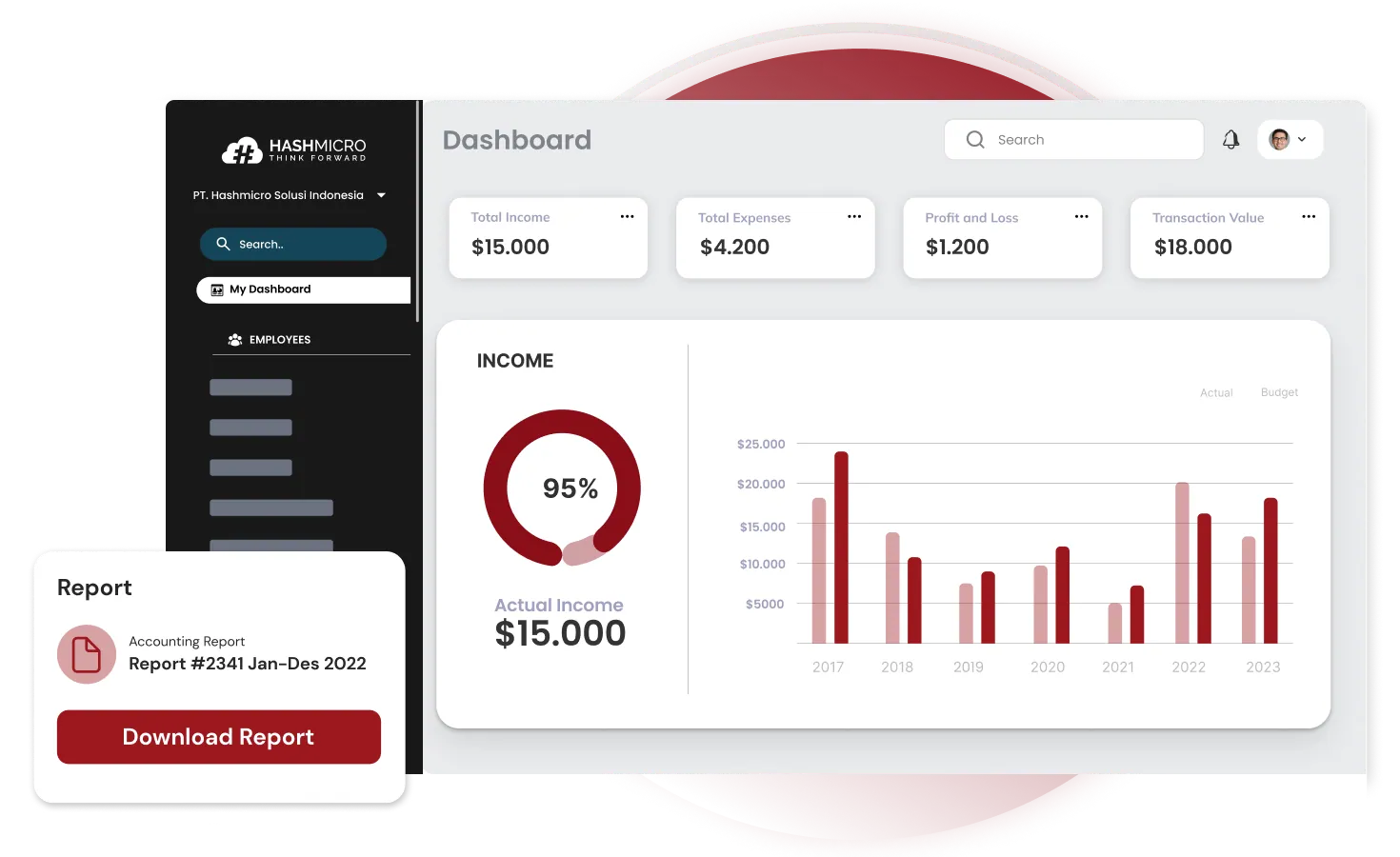Manual journal entries may seem straightforward, but they often cause many issues. Errors can throw off the debit-credit balance, transactions may be misclassified, and hours can be wasted searching for minor mistakes, like needles in a haystack. A journal entry example can help clarify how these issues arise and how to avoid them.
If managing and recording assets and liabilities manually feels overwhelming, consider using accounting software to streamline the process. This powerful tool can quickly record, track, and generate various documents, including journal entries, in an instant.
Still unsure about how journal entries work or why they’re crucial for your business? Keep reading to see a detailed journal entry example and discover how ERP software offers a more efficient way to manage journal entries—helping you streamline accounting processes and avoid costly mistakes.

Key Takeaways
|
Understanding Journal Entry
A journal entry in accounting records a company’s financial transactions in its books. Creating a journal entry involves documenting the transaction details as part of the accounting cycle’s second step, before transferring them to the general ledger.
Journal entries are fundamental to any accounting system and form the foundation of accurate financial records. Each entry in the general ledger includes the transaction date, amount, affected accounts with their numbers, and a brief description.
It may also include a reference number, such as a check number, and a brief note explaining the transaction. Every journal entry has two sides, a debit on the left and a credit on the right, to maintain the accounting equation:
Assets = Liabilities + Equity
Together, these entries create a complete, chronological record that captures the transaction date, impacted accounts, amounts, and a clear description of the transaction.
Where is the Journal Entry Recorded?
A journal entry is recorded in a business’s general ledger, which serves as the primary record of all financial transactions. It ensures each entry is accurately documented and can be referenced in financial reports.
Besides the general ledger, journal entries may also be recorded in subsidiary ledgers that provide detailed information on specific accounts and transactions before being consolidated into the general ledger.
Additionally, adjusting journal entries are typically made at the end of an accounting period to ensure that income and expenses are appropriately matched to the correct period.
Why Are Journal Entries Important?
Journal entries are crucial for ensuring financial accuracy and supporting dependable financial reporting. Their primary purposes include:
- Recording transactions: Every financial transaction is carefully documented to capture all details accurately.
- Tracking activity: Journal entries create a chronological record of all business-related economic events.
- Supporting audit trails: They enable auditors to trace discrepancies back to their origin, ensuring financial integrity.
- Preparing financial statements: By maintaining consistent and accurate records, journal entries provide the basis for preparing financial statements, such as income statements, balance sheets, and cash flow statements.
Key Elements of a Journal Entry
To maintain accurate and organized financial records, every transaction must be carefully documented with specific details. It helps ensure clarity and consistency throughout the accounting process. An accounting journal entry includes these key components:
- Transaction date: Ensures transactions are recorded in chronological order and within the correct accounting period.
- Account names/numbers: Specifies the accounts impacted by the transaction.
- Debit and credit amounts: Shows the monetary values involved, maintaining balance in the accounting equation.
- Description or narrative: Provides a brief explanation of the transaction for clarity and context.
For example, imagine a business in Malaysia secures a loan of RM10,000. The journal entry would be:
- Date: [Date of Transaction]
- Debit: Cash RM10,000
- Credit: Loans Payable RM10,000
- Description: To record the borrowing of an RM10,000 loan.
This entry reflects an increase in the company’s cash (an asset, hence debited) and a corresponding decrease in loans payable (a liability, therefore credited), as required by the accounting equation.
Types of Journal Entries
Companies in Malaysia commonly use two main types of journal entries: the sales journal entry and the allowance for doubtful accounts entry. Let’s take a closer look at each one.
1. Sales Journal Entry
This entry documents your business’s revenue from selling goods or services. It records the sales value, the reduction in inventory from customer purchases, and any applicable sales tax. The details can vary depending on how the customer makes their payment.
2. Allowance for Doubtful Accounts Entry
Known as a contra-asset, this entry reduces the company’s receivables to account for potential credit risks and uncollectible debts. As a result, it helps estimate possible losses from accounts that may not be paid, providing a more accurate picture of expected revenue.
For businesses handling accounts receivable, recognizing potential bad debts ensures financial statements reflect an accurate and fair view. Additionally, correctly classifying notes receivable facilitates tracking outstanding balances and assessing repayment reliability.
Besides these two main types, there are other journal entries, including:
- Opening entries: Set the initial balances in ledger accounts.
- Transfer entries: Move amounts between accounts to reflect accurate financial impacts.
- Closing entries: Recorded at the end of an accounting period to transfer balances from temporary to permanent accounts.
- Adjusting entries: Made before finalizing financial statements to record items not yet accounted for by period-end.
- Compound entries: Involve multiple debits and credits across several accounts within one entry.
- Reversing entries: Created at the start of a new period to reverse specific adjustments made in the prior period.
Each type of journal entry corresponds to specific accounting practices tailored to different situations and requirements.
Best Practices for a Journal Entry
Efficiently preparing and accurately documenting journal entries can be a complex task. Here are some best practices to help streamline the process:
- Avoid high-volume transactions
Avoid creating journal entries for high-frequency transactions, such as customer billings or supplier invoices. Utilize dedicated accounting software with standardized online forms to automatically generate necessary records, thereby eliminating the need for manual entries. - Use a journal entry template
Creating a template for recurring journal entries in your accounting software saves time. Furthermore, it should include commonly debited and credited accounts for quicker, more accurate entries. Templates not only boost efficiency but also reduce errors. - Implement a retention policy
Journal entries and their supporting documents should be retained for a minimum of several years, until the related financial statements are no longer subject to audit. Your company’s archiving policy should specify the minimum retention period for these records.
How Journal Entries Are Made
There are two primary bookkeeping methods and accordingly, two ways to make journal entries: single-entry and double-entry.
- Double-entry bookkeeping
Double-entry bookkeeping is like a GPS for your finances, showing where your money comes from and where it goes. In other words, it records both sides of every transaction, providing a complete view of your financial activities. - Single-entry bookkeeping
Single-entry bookkeeping is simpler. For example, if you purchase office supplies, simply record the expense as incurred. If you make a sale, you note it down without detailing the source of funds or where the sales deposits are allocated.
Although single-entry bookkeeping is easier, double-entry bookkeeping is more widely used in Malaysia because it provides a more thorough understanding of a business’s financial health. If you find double-entry bookkeeping challenging, using reliable accounting software can significantly simplify the process.
Methods to Track Journal Entries
Accurate journal entries form the foundation of reliable financial records and meaningful reporting. Following these essential steps helps maintain consistency. Here’s how to prepare a journal entry:
- Organize transaction details: Gather and verify all necessary documents, such as invoices and receipts.
- Analyze the transaction: Identify the accounts involved and determine the transaction amount.
- Apply the accounting equation: Ensure that Assets = Liabilities + Equity holds after the transaction.
- Follow debit and credit rules: Decide which accounts should be debited and which should be credited.
- Record the entry: Input the transaction into the journal with complete and accurate details.
- Review: Periodically check journal entries to ensure ongoing accuracy and consistency in the financial records.
Effective tracking of journal entries is essential for maintaining accurate financial records and supporting sound decision-making. Proper tracking methods enhance transparency and facilitate future audits. Regular monitoring is crucial to preserve the integrity of the records. Key strategies include:
- Use accounting software: Utilize modern financial reporting software that streamlines data entry, tracking, and detailed reporting.
- Conduct regular audits: Schedule routine internal audits to verify the accuracy and completeness of entries.
- Assign unique reference numbers: Assign a unique reference number to each journal entry for easy retrieval and verification.
- Maintain detailed documentation: Keep thorough records for every transaction to back up the related journal entries.
To effectively manage your financial records, it’s vital to have reliable methods for tracking journal entries. To support your accounting needs further, you can download our detailed pricing scheme below, designed to help you choose the best solution for seamless journal entry management.

The Role of Debit and Credit in Journal Entry
In accounting, debit and credit are the fundamental elements of any journal entry. They reflect the two sides of every transaction, ensuring the accounting equation stays balanced. A debit increases assets or expenses, meanwhile a credit increases liabilities, equity, or revenue.
For example, when a business buys office supplies with cash, the supplies account is debited, and the cash account is credited. This dual entry accurately records both the increase in supplies and the decrease in cash. Such examples are crucial for maintaining clear and accurate financial records.
For that reason, using practical journal entry examples helps businesses grasp how debits and credits work in real situations. Understanding these principles is crucial for accurate accounting and effective financial management, whether managing everyday expenses or complex transactions.
Journal Entry Examples
These transactions come from TechNova Solutions, a fictional small IT services and equipment supplier based in Kuala Lumpur. TechNova Solutions offers tech support to local businesses, sells IT equipment, and manages its inventory.
The following examples of journal entries illustrate the company’s typical business transactions and demonstrate the proper accounting journal entry format used to maintain accurate and well-organized financial records.
Example 1: Purchasing Inventory on Credit
Date: January 5, 2023
- Debit: Inventory RM15,000
- Credit: Accounts Payable RM15,000
- Description: Purchased 10 units of computer monitors on credit.
Explanation:
In this example of a journal entry in accounting, TechNova Solutions bought computer monitors to add to their inventory, but has not yet paid the supplier. The “Inventory” account is debited (increased) by RM15,000 to reflect the new stock, while “Accounts Payable” is credited to record the amount owed to the supplier.
Example 2: Recording Depreciation
Date: January 31, 2023
- Debit: Depreciation Expense RM2,500
- Credit: Accumulated Depreciation RM2,500
- Description: Monthly depreciation recorded for office equipment.
Explanation:
In this journal entry example of accounting, TechNova Solutions records monthly depreciation for office equipment like computers and printers. The “Depreciation Expense” account is debited for the monthly wear and tear cost, while “Accumulated Depreciation” is credited to track total depreciation on the equipment.
Example 3: Service Revenue Earned and Received in Cash
Date: February 2, 2023
- Debit: Cash RM10,000
- Credit: Service Revenue RM10,000
- Description: Received cash payment for on-site tech support provided to a corporate client.
Explanation:
TechNova Solutions received cash from a client for delivering on-site tech support services. The “Cash” account is debited (increased) by RM10,000 to record the payment received, while “Service Revenue” is credited to reflect the income earned from the service.
Example 4: Employee Salary Payment
Date: February 15, 2023
- Debit: Salaries Expense RM20,000
- Credit: Cash RM20,000
- Description: Paid employee salaries for the first half of February.
Explanation:
TechNova Solutions paid RM20,000 in employee salaries for the first half of the month. The “Salaries Expense” account is debited to record this cost, while “Cash” is credited to reflect the decrease in the company’s cash due to the salary payment.
Example 5: Loan Payment with Interest
Date: February 20, 2023
- Debit: Loans Payable RM8,000
- Debit: Interest Expense RM500
- Credit: Cash RM8,500
- Description: Partial repayment of the loan, including interest.
Explanation:
TechNova Solutions made a payment of RM8,500 toward a loan, consisting of RM8,000 principal and RM500 interest. The “Loans Payable” account is debited to reduce the loan balance, “Interest Expense” is debited to record the interest cost, and “Cash” is credited to reflect the cash outflow.
Journal Entry Examples with Tables
The transactions in this lesson involve Ali’s Auto Repair, a fictional small business based in Kuala Lumpur. Please note that all transactions are simplified examples intended to aid learning. These are sample journal entries for bookkeeping to help you understand the process. Let’s get started.
Transaction #1
On January 1, 2023, Ali invested RM500,000 to start Ali’s Auto Repair. The journal entry will increase the company’s Cash account and establish Ali’s capital account.
| Date | Particulars | Debit | Credit |
| January 1, 2023 | Cash | RM500,000 | |
| January 1, 2023 | Ali’s Capital | RM500,000 |
Transaction #2
On January 5, Ali’s Auto Repair paid RM18,000 for registration fees.
| Date | Particulars | Debit | Credit |
| January 5, 2023 | Registration Expense | RM18,000 | |
| January 5, 2023 | Cash | RM18,000 |
Transaction #3
On January 8, Ali’s Auto Repair purchased tools and equipment worth RM150,000, paid in cash.
| Date | Particulars | Debit | Credit |
| January 8, 2023 | Tools and Equipment | RM150,000 | |
| January 8, 2023 | Cash | RM150,000 |
Transaction #4
On January 10, Ali’s Auto Repair purchased supplies worth RM25,000 on credit.
| Date | Particulars | Debit | Credit |
| January 10, 2023 | Supplies | RM25,000 | |
| January 10, 2023 | Accounts Payable | RM25,000 |
Transaction #5
On January 12, Ali’s Auto Repair earned RM80,000 from repair services, received in cash.
| Date | Particulars | Debit | Credit |
| January 12, 2023 | Cash | RM80,000 | |
| January 12, 2023 | Service Revenue | RM80,000 |
Transaction #6
On January 15, Ali contributed an additional RM200,000 to the business.
| Date | Particulars | Debit | Credit |
| January 15, 2023 | Cash | RM200,000 | |
| January 15, 2023 | Ali’s Capital | RM200,000 |
Transaction #7
On January 20, Ali’s Auto Repair provided services worth RM120,000 to a corporate client on credit, with payment due in 30 days.
| Date | Particulars | Debit | Credit |
| January 20, 2023 | Accounts Receivable | RM120,000 | |
| January 20, 2023 | Service Revenue | RM120,000 |
Transaction #8
On January 25, Ali’s Auto Repair collected RM60,000 from a previous accounts receivable.
| Date | Particulars | Debit | Credit |
| January 25, 2023 | Cash | RM60,000 | |
| January 25, 2023 | Accounts Receivable | RM60,000 |
Transaction #9
On January 28, Ali withdrew RM50,000 for personal use.
| Date | Particulars | Debit | Credit |
| January 28, 2023 | Ali’s Drawings | RM50,000 | |
| January 28, 2023 | Cash | RM50,000 |
Transaction #10
On January 31, Ali’s Auto Repair paid RM45,000 in employee salaries.
| Date | Particulars | Debit | Credit |
| January 31, 2023 | Salaries Expense | RM45,000 | |
| January 31, 2023 | Cash | RM45,000 |
These transactions serve as a practical guide to recording journal entries for a small business in Malaysia, including examples such as a credit note journal entry with example to help you understand various scenarios.
How HashMicro Accounting Software Makes Journal Entry Recording Simple and Efficient
Let’s be honest, manually handling accounting tasks can be tedious. It’s time-consuming, prone to errors, and easy to lose track of records. These challenges make financial management difficult for many business owners.
With HashMicro Accounting Software, these problems become a thing of the past. The software takes care of the details, minimizing mistakes and saving you valuable time. Your records remain organized, accurate, and accessible whenever you need them.
HashMicro offers a range of features designed to simplify the process of making journal entries:
- Integrated with Hashy AI for Finance: Uses a chat-based interface to automate customer invoicing, payment tracking, and vendor communication. It processes payables and collections automatically to maintain accurate cash flow records.
- Bank integration: This feature automatically matches bank transactions with your internal records, streamlining the reconciliation process.
- Multi-level analysis: Journal entries are often organized by project, branch, or specific account, and this feature provides detailed analysis at multiple levels.
- Cash flow reports: Since journal entries affect cash flow, having real-time cash flow reports linked to these entries is highly beneficial.
- Financial statements with budget comparison: As journal entries influence financial statements, this feature provides insights by comparing actual results against the budget.
- Profit & Loss vs. Budget & Forecast: This feature highlights the impact of journal entries on profitability and budgeting, enabling users to assess their financial health and adjust entries to meet business objectives.
Conclusion
To conclude, journal entries are crucial records of every financial transaction, enabling businesses to maintain accurate and organized financial records. Each entry captures the transaction date, the accounts involved, and the corresponding debit and credit amounts.
Managing journal entries manually can be time-consuming and prone to errors, which makes accounting software an essential tool. HashMicro Accounting Software streamlines this process by automating entries, reconciling bank transactions, and delivering real-time reports.
Don’t just take our word for it. Try the free demo and contact our expert team today!

Frequently Asked Questions About Journal Entry Example
-
What are compound journal entries?
Compound journal entries involve multiple accounts with more than two debits and/or credits recorded in a single transaction. They are used when a single transaction affects numerous accounts simultaneously. For instance, processing payroll may debit salary expenses and various tax expenses while crediting cash and tax payable accounts.
-
How does a journal entry differ from a ledger entry?
A journal entry is the initial detailed record of a financial transaction, whereas a ledger entry organizes these transactions into specific accounts, which helps in preparing financial statements.
-
What distinguishes adjusting entries from regular journal entries?
Adjusting entries are made at the end of an accounting period to update account balances for items like accrued income or unpaid expenses that haven’t been recorded yet. Regular journal entries are recorded as transactions occur throughout the period.


























